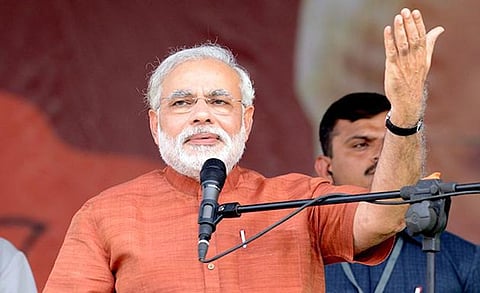By Gaurav Sharma
Yesterday, India celebrated its 68th year of Independence. From tenderly treading baby steps in the nascent stages of nationhood to galloping briskly towards a greater stake in the global economy, the Indian journey has been a roller-coaster ride.
Monikers such Shining India and the Bright spot highlight the growing economic clout of the country and arouse global interest in India, both as a market and an investment hotspot.
What was once the tedious Hindu rate of growth of 1 per cent in the first three decades following a century of exploitative British colonization has now rocketed into a burgeoning 7 per cent growth trajectory. When the World Bank expects India to top its growth outlook charts for 2015-2016, with the economy growing steadily between 7.5-8.3 per cent, it further cements the India's rise as an economic power.
How did we traverse the topsy-turvy journey, through the crest and the trough? How did we reach the current state of being?
After Independence, India's first Prime Minister Jawaharlal Nehru (through the statistician Prasanta Chandra Mahalanobis) undertook a socialist reform of the country. Skeptical of his colonial experience, Nehru adopted a protectionist economic policy, under which development came largely under the ambit of the government. Central planning, regulation and import substitution emerged as the key features of the Five Year Plans based upon the Soviet model.
Nehru's reply to industrialist JRD Tata, "Never talk to me of profit. It is a dirty word", emboldens the denigrating and suspicious mindset of politicos towards the private sector prevailing during that time. Industries such as steel mining, insurance among a host of other industries were controlled and run by the public sector.
In 1965, the Green Revolution was ushered in, to facelift the agriculture sector. Use of high yield variety seeds (HYV) and genetically modified (GM) crops not only resulted in India achieving self-reliance in food security but also stealthily brought the problem of income disparity and institutional breakdown to the fore.
Although the Morarji Desai government of 1977 did ease restrictions on the economy by removing price controls and reduction of tax rate, by the end of the decade India was staring itself in the dark pit of external payment crisis. With the disintegration of Soviet Union and a sharp decline in oil prices, India's balance of payments (BoP) had enlarged to dangerous proportions.
India was forced to borrow a heavy sum of Rs 28,000 crore from the International Monetary Fund (IMF), the largest sum for any developing nation at the time.
In the 1980's, the Indira Gandhi government was successful in stalling the prospective deterioration underlined in the loan conditions, by unleashing a slew of reform measures such as reducing import duties, delicensing industry and revamping the public sector. Transformation was on it way.
Then in 1991, a breakthrough was achieved by Narasimha Rao while working in tandem with the then finance minister Manmohan Singh. Public monopoly came to an end, interest rates and tariffs were reduced, license raj was quashed and the country was opened up to the world. Globalization, Privatization and Liberalization emerged as the motto of the new dispensation.
The new millennium (particularly the period 2003-2007), saw India touch a high 9 percent growth rate, with Goldman Sachs predicting India to become the third largest economy by 2025.
Despite donning the hat of the new global economic power, India's fundamentals were tested during the 2008-09 recession. Although it managed to brace through the economic cyclone, in the aftermath of the disaster, India's growth rate had tumbled down below 5 per cent.
High current account deficit, weak rupee and a sluggish manufacturing sector aggravated the situation. Furthermore, the tapering of quantitative easing in the US meant that foreign investment into the country ebbed. India's global standing took a hit even as the ease-of-doing-business index ranked at an abysmal 142 out of 189 countries.
Fast track to today. And with the change in political power, things have started changing. With almost 15 years of developmental experience behind his back, Narendra Modi has promised a slew of reforms aimed at reviving India's economic muscle.
Critical sectors of the economy have been opened-up to woo foreign investors and to revivify the ailing sectors. FDI in defense has been increased to 100 per cent and insurance FDI limit has spiked up from 26 to 49 per cent.
Not to get fixated with the idea of growth as the sole plank of development, Modi has also vied for social initiatives. This is in line with what Amartya Sen (a notable critic of Modi) believes economics to be; a value of freedom not limited to a utilitarian concept of wealth and income.
On his Independence Day speech, Modi continued with his hawkeye focus on development and boisterously claimed that his government had scaled down the complex labour laws into 4 simplified codes; safety, social security, wage and industrial relations. It will be interesting to see how the grand plan actualizes.
If Kisan Kalyana Yojana ends up as mere rechristening of the agriculture ministry rather than a new scheme, Modi's credibility will surely take a hit. Dreaming of an entrepreneurial revolution and setting a target of three years for rural electrification plans are ambitious plans indeed. Still, in the midst of the precocious focus on development, the key area of electoral reforms has been left untouched.
This only shows how adept Modi is when it comes to towing the precarious line of economic reforms and social development–of leadership and populism–with much alacrity. If only as a photo-op, critical social issues have not been left sidelined.
Perhaps this how the neo-hindu statesman works. When, and if he walks the talk, can we expect a new neo-Hindu rate of growth?


